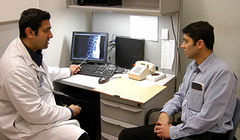Managing the data
The data entered into the computer is managed through special database packages specifically developed for health care environment. These software are used to sort, store, search and retrieve information about patients.
Commonly used software are Microsoft Access, PinPoint, dBase.
Usually hospitals use a relational database. A relational database consists of one or more tables, which contains information about entities. An entity is simple one type of ‘object’, such as a patient in the hospital. The information about each patient makes up one record, which is divided into fields just as in an ordinary data file. A field consists one individual item of data about an entity, such as patient’s name, sex, age, doctor, medical condition, and medical history.
Each type of entity is store in a separate table. Tables are linked together by common fields. The links between tables are called relationships.
Thus different users, such as doctors, nurses and patient will have access to data stored in different files. However, not all users will be given permission to look at all the data.
Transferring data
In cases where the patient’s data has to be transferred inside the hospital building, Local Area network can be used.
Hospitals use internet to communicate patients regarding their appointments, reports and other issues. Internet is browsed using browsing software. Common examples are Microsoft Explorer, Mozilla Firefox and Safari.

Doctors and other hospital staff can view these data using a Computer monitor or print out hardcopies through a Printer.




